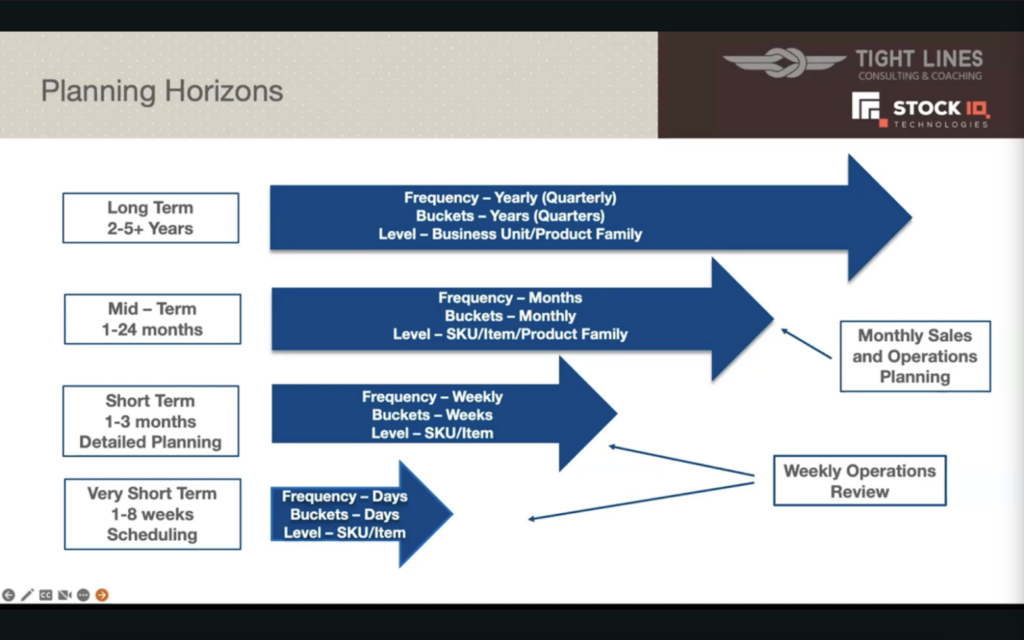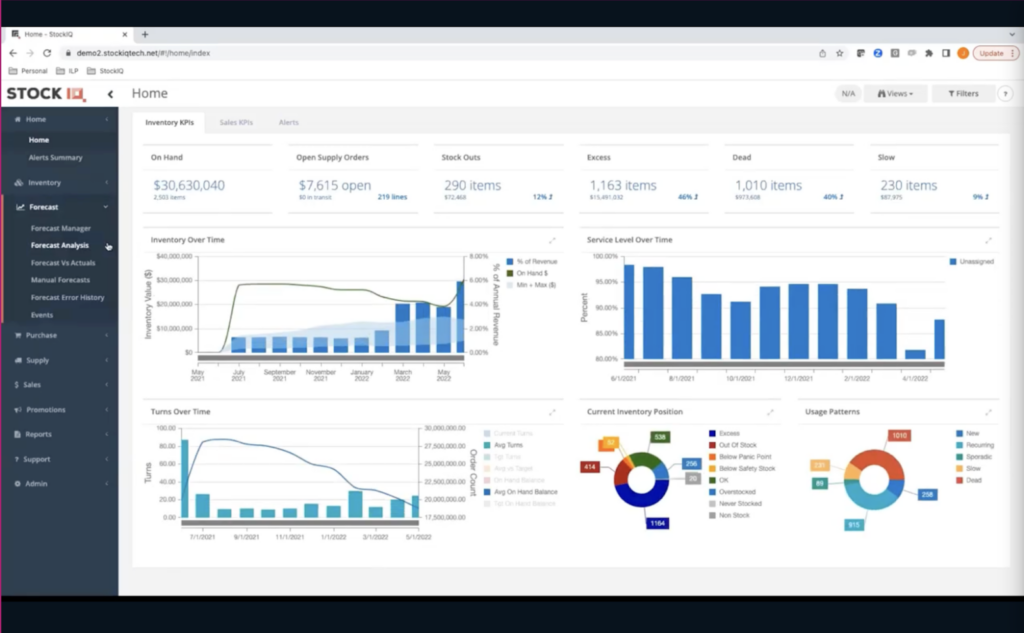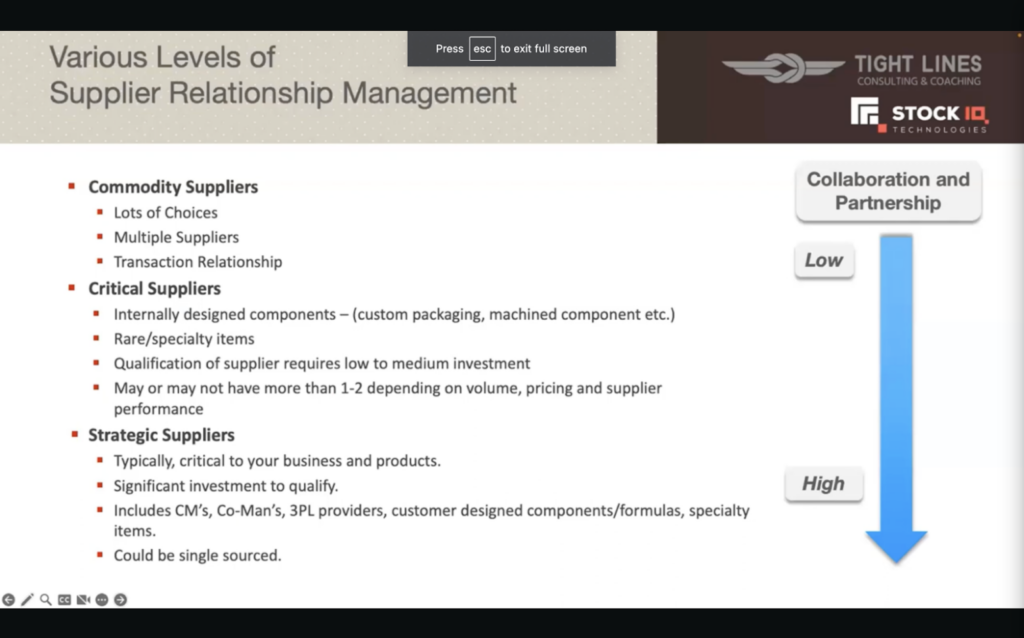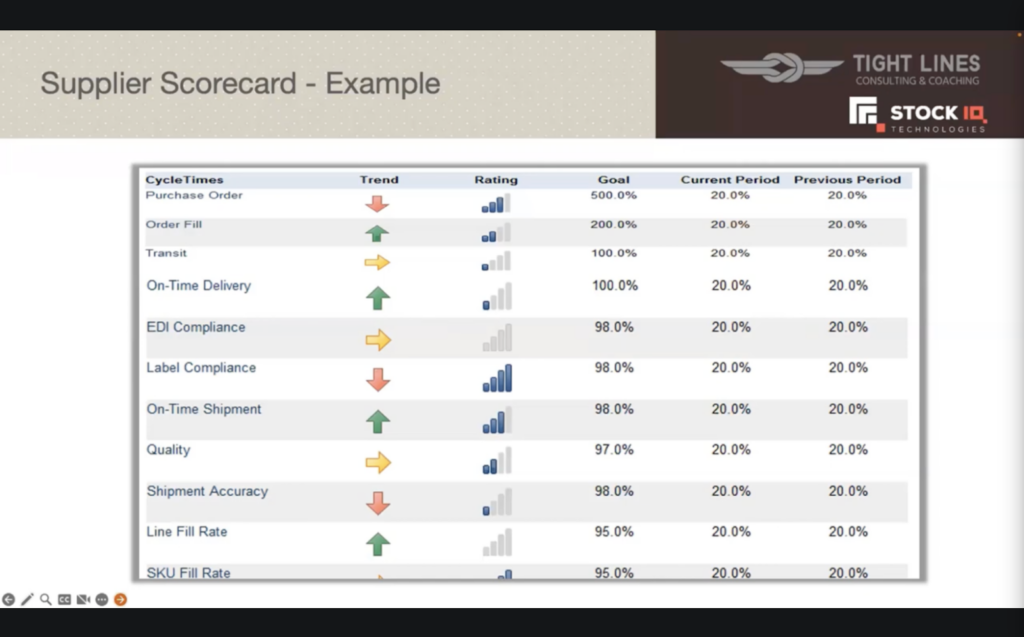Managing a supply chain is a vast, complex effort that requires decision-makers to collaborate internally, navigate external suppliers, and operate in notoriously unpredictable market conditions. But when you take a strategic, data-driven approach to managing your inventory and processes, you can best meet demand, keep operations running smoothly, and meet the needs of your customers. To masterfully navigate and control your supply chain, you can use supply chain planning software, which gives you maximum control and visibility over the core supply chain capabilities and processes.
This article will discuss everything you need to know about supply chain planning software, including an in-depth discussion of the three supply chain capabilities, and tips on properly and effectively using supply chain planning software during each stage.
Understanding Supply Chain Management
There’s a lot of noise in the supply chain management space today, from resiliency to artificial intelligence (AI). But if you want to get to the bottom of properly managing your supply chain, you need to understand and address the three core processes and use supply chain planning software to do so.
But first, let’s start by dissecting supply chain management. Supply chain management is something that we consider to be “a cross-functional contact sport,” which involves R&D, sales/marketing, finance, and supply chain. The goals of supply chain management are to attain/grow revenue, manage assets, and manage costs/margins. For these goals to be accomplished, organizations must align their cross-functional processes by utilizing supply chain planning software.
Consider the inverse: if your organization doesn’t have integrated processes, it’s pretty easy for things to become disconnected. This can manifest as selling things you don’t have in inventory, or improperly managing costs of the market, for example.
Most manufacturing companies have similar core processes, which expand beyond supply chain management (and which include areas such as HR and IT). But the three core supply chain management processes (which we’ll discuss in-depth in a little while) are integral to business outcomes, and can really “make or break” a business. These are forecasting & planning, supplier management, and inventory management.
Supply chain management is not only a contact sport, it’s also a team sport and requires everyone (and every department in your organization) to be aligned on the numbers and metrics.
Getting Started with Supply Chain Management
If you don’t yet have strategic supply chain management processes in place, it’s best to first get started with the tools at your disposal. Here are some steps you can take right now to address supply chain management in your organization:
- Assess your current processes: Begin by assessing the core, cross-functional processes in your organization. Establish what the current processes are, and where your weakest links are.
- Get started: Even if your technology is not the latest and greatest (right now), you can still get started with proper supply chain management. From older ERPs to simple spreadsheets, there are ways to get started with what you have.
- Consider new technology: Consider expanding or updating your supply chain technology infrastructure. Keep in mind that this space is expanding rapidly, and is expected to grow in value from $15 billion in 2020 to almost $31 billion by 2026. But also, remember that your organization needs to have well-established core processes for this software to thrive. In some cases, if technology is not first supported by an underlying process, it can do a disservice to the business.
The Three Core Capabilities of Supply Chain Management
There are three supply chain core capabilities that dictate how your business functions, and which you should address within your organization. They are:
1. Forecasting & Planning
These processes refer to proactively planning your revenue, inventory investments, cash flow, and financial results, which allow your business to operate proactively.
2. Supplier Management
Referring to different levels of supplier relationship management, taking into account commodity suppliers, critical suppliers, and strategic suppliers. Supplier management uses key processes (such as forecasting & planning, metrics, and business reviews) to strategically navigate these relationships.
3. Inventory Management
This dictates how inventory and supply are managed and tracked in your business, and includes ABC stratification, XYZ analysis, service levels, and order policies. It’s not only the physical movement of inventory but also covers your inventory strategy around your processes.
The Issue with Supply Chain Management
While many organizations understand these processes and utilize some form of them, there’s typically a big issue at hand: these processes are often fragmented and siloed if they’re in place at all. There can also be disagreements over the data, and who has ownership.
For example, who owns the forecast? Sometimes, the answer to this question in an organization isn’t clear, which can lead to conduction. I would like to replace conduction with another word – possibly confusion.
In most cases, it’s common for sales & marketing to own the forecast. But even so, procurement & supply chain planning buyers should be the checks and balances in this system. Remember: (I would suggest a comma instead of a colon) nothing happens in a vacuum, and the information and data need to be democratized.
In most cases, it’s common for sales & marketing to own the forecast. But even so, procurement & supply chain planning buyers should be the checks and balances in this system. Remember: nothing happens in a vacuum, and the information and data need to be democratized.
Successful supply chain management requires a comprehensive approach to all three core processes, and the proper deployment of supply chain planning software to support these processes.
Diving into the Planning Processes
The planning process might be the most underrated of the three core processes because historically, organizations that have a consistent, repeatable planning process are more resilient, better prepared, and less at risk. On the other hand, when an organization lacks an underlying foundation of planning, it’ll likely see more reactive and “firefighting” strategies.
There are three components to the planning process:
- Demand planning
- Supply/inventory planning
- Financial planning
There are also different planning horizons for you to be aware of, some that are more frequent than others.
- Long-term: 2-5 years or more. This is yearly or quarterly planning, done at the business unit or product family level.
- Mid-term: 1-24 months. This is done monthly and at the SKU, item, or product family level. Here is where monthly sales & operations planning (S&OP) occurs.
- Short-term: 1-3 months. Weekly planning, at the SKU or item level. Many organizations emphasize the short-term, but without an underlying foundation of planning, this can lead to the need for more reactive action.
- Very short-term: 1-8 weeks. Daily planning, at the SKU or item level.

Usually, businesses will deal with the mid-term planning process, also called the S&OP.
Understanding the S&OP Process
The Sales and Operations Planning process is an integrated, cross-functional plan, that’s not just reserved for larger organizations. It’s integrated in the sense that it has a demand plan, an operations inventory supply plan, and a financial plan with consistent assumptions. Ultimately, it should result in a complete picture of what your organization’s financials will look like if the plan comes to fruition.
While S&OP is further up the maturity scale in processes, it’s common for organizations to take a less comprehensive approach to ordering, which results in stockouts and overstock scenarios. A smaller company can approach the S&OP process successfully, but it’s necessary to have the right supply chain planning software and guidance.
Who drives the S&OP process?
It’s a question that comes up often: in an organization, who drives the S&OP process? While this answer differs from organization to organization, it’s typically a collaborative process, between Sales, Ops, and Finance, and is driven first by Ops.
Regardless of your answer, the key takeaway here is that there are many data elements, assumptions, and structures that need to be aligned between all of the relevant parties.
Another crucial element to keep in mind: there should be a process owner. Whether you decide that’s Finance, Ops, or perhaps Sales, a process owner is key to seamless execution. In some cases, there might even be a designed Sales & Operations Planning Coordinator.
Demand Planning
Demand planning is the process of using demand forecasting to inform your ordering and inventory decisions. Demand planning can also be referred to as an Unconstrained Shipment Plan.
There are several data points which are used to inform demand planning:
- Statistical Analysis: Based on historical data and past purchasing information. Can be used to anticipate holidays and seasonality, for example.
- Marketing/Sales Input: If there’s promotional activity or other relevant data from the Marketing and/or Sales teams.
- Product Management: This is particularly relevant if there are product transitions or new product introductions.
- Customer Input: This is relevant when you have relationships with customers that provide you with insight into their inventory needs.
A demand plan/forecast is typically created for 1-18+ months. While this is a fairly broad period, this decision will ultimately be based on your suppliers, their sourcing, and their lead times.
Demand planning requires large amounts of real-time data, but it should not be a debilitating effort. If you’re using relevant supply chain planning software, for example, a demand plan can be generated in half a day or a day. If you’re collecting a lot of customer input, it might take several days. But if you don’t have formal technology in place, it can take much longer.
The Role of Technology in Demand Planning
As we’ve discussed, there is supply chain planning software and other technology available that will assist in creating a demand plan. This technology can help us distill key insights from the data, such as there is a seasonal profile associated with products, when peak demand periods are, and when low “valleys” are. Technology can help us determine these patterns over many years of history, and understand how consistent these trends are.
Another way technology helps with demand planning is through generating a projection of inventory positions. Input coming in from the sales team can be used to project inventory positions for each SKU, based on the execution and alignment of a forecast.
With supply chain planning software, you can also isolate different inputs into your models, and you have mechanisms to adjust your forecasts based on all of the collaborative, relevant data.
Ultimately, if you’re trying to make strategic decisions around product positions, and you’re looking to accurately plan your supply, these tools give you quick feedback and help you make decisions on the spot.

Ultimately, your demand plans should be informed through collaborative data. When you consider statistical forecasting, sales and marketing data, and customer input, you have an opportunity to come to a consensus on what the final demand numbers will look like. And when you have the current supply chain planning technology in place, you can “rinse and repeat” the demand planning process.
Mastering Supplier Relationship Management
Having programs and processes in place to manage your supply base is critical to meeting your objectives. Supplier relationship management is essential for building resiliency and weathering volatility and can help you properly diversify your supplier base, build strong relationships with suppliers, and implement supply chain risk management processes.
While all suppliers are important at some level, not all are created equal. These are the different levels of supplier relationship management:
- Commodity Suppliers
- Instances where there are many choices, multiple suppliers, and you’re operating in a transactional relationship. While these relationships can still be strong, suppliers in this category are typically at less risk.
- Critical Suppliers
- These suppliers might provide custom packaging/components, you might have some options (but not an abundance), and they typically require higher spend.
- Strategic Suppliers
- These suppliers are critical to your business and products and require a significant investment. Sometimes, they’re single-sourced.

There are also key processes for supplier relationship management. These are:
- Forecasting and Planning
- Suppliers like to be aware of what’s going on, and what’s coming. You can send suppliers monthly forecast updates and other data, to help give them a better opportunity to meet your needs. For example, when clients use the forecasting tools in StockIQ, they can send those forecasts to suppliers. When suppliers know the quantity of expected demand, value the vendor relationship, and have access to transparent data, they’re oftentimes able to get the product to you faster, and even prioritize your orders.
- Metrics
- These metrics reflect supplier performance. Common ones to monitor include On-Time Delivery, Cost, Technology, and Responsiveness.
- Business Reviews
- Conducted monthly, quarterly, or semi-annually, these formal meetings have a structured agenda and might cover updated business topics, cost trends, and history. They’re also an opportunity for you to get to know your supplier’s business better, and better manage risk.
Introducing the Idea of Business Reviews
If you don’t currently conduct business reviews with suppliers, you might have questions about how to first approach them about a regular review process. Start with key suppliers, and create a plan for how you want to engage with them. Keep in mind, that most suppliers are open to having this dialogue, especially if you’re a growing business. Most suppliers will also be open to sharing information, talking about costs, de-risking the supply chain, and creating resilience.
- Next steps: Start with a manageable amount (1-3 suppliers), and create a plan, including frequency and what type of metrics and data you want. Don’t only engage with a supplier when there’s a problem, and you’re in “firefighting mode.” When you proactively conduct business reviews, you can share valuable information, while also having better processes for managing problems. Research shows that companies can spend up to 27% of their revenue on external suppliers and that when mismanaged, up to a quarter of the negotiated value can be lost over the term of the deal. Proper supply relationship management can help your business secure inventory, minimize excess costs, and work better with your suppliers.
The Role of Technology in Supplier Relationship Management
Technology can be a vital asset when it comes to strategic supplier relationship management. For example, when you use StockIQ, you’ll have access to a supplier scorecard, which measures supplier performance. There are many metrics available to you here, including the total number of orders, lead time, how many were on time, and discrete order-level information.

This data is essential for supplier relationship management, especially when you’re conducting business reviews. For example, you don’t want to approach suppliers with incomplete information, or information that’s not accurate.
There are many other ways supply chain planning software can enhance the way you manage supplier relationships. For example, you can take advantage of tools such as measuring, which demonstrates how you’re performing on a particular line item. This information can also be shared internally (such as with your finance team) and can be integrated with your demand plan and product plan to support decision-making.
Leveraging Inventory Management
Inventory management can be thought of as a cornerstone of supply chain management, and a place where we see many benefits and opportunities.
Here are the key components of inventory management:
1. ABC Stratification
Grouping items based on their value to both the inventory and to the company. This is a great place to start for understanding the value and dynamics of your inventory. ABC Stratification typically includes between 1 and 5 classes and considers sales history and the velocity of products. ABC Stratifications should be updated regularly (whether that’s daily, weekly, monthly, or quarterly).
When organizations are not using a technology or process to guide ABC stratification, they typically assign a classification to an item at its introduction. However, as products fluctuate, the overall position of that SKU can change. Because of this, it’s important to conduct ABC Stratification on a frequency that reflects the movement and the change of your products.
2. XYZ Analysis
Categorizing items based on forecastability and predictability. You might have some SKUs which are very predictable and steady but might have others with a lot of variability. For example, newer products or new product categories can be difficult to forecast.
The groupings of this inventory management process are as follows:
- X– The most forecastable, with low demand variation that is predictable.
- Y– Moderately forecastable, with more variation in the demand amount.
- Z– Least forecastable, with the most demand variation. The hardest to predict.
XYZ Analysis does not dictate the importance of inventory items but simply identifies how they behave, which helps us establish the right stocking policies. XYZ Analysis is calculated based on one of three measurements: the Coefficient of Variation, Historical Statistical Model Error, or Usage Pattern.
3. Service Level
This addresses the question “How do I want to service these SKUs?” It also addresses considerations such as stockout and risk. Depending on the value of the inventory, you might want to have higher or lower service levels for a SKU
Service Level essentially refers to the expected probability of not having a stockout. The percentage of Service Level correlates with safety stock needs to ensure inventory availability. As you raise service levels, it drives inventory investment.
Service level is also one of the four factors in the item-site Safety Stock calculation:
- Statistical Forecast Error
- Lead Time
- Forecasted Usage
- Target Service Level
By pinpointing exactly how much inventory is required from a safety stock perspective, we can use that insight to meet goals and objectives within the organization.
4. Order Policy
This controls how and when items are ordered and replenished. There are many different methods for determining this, for both stock and non-stock items. For example, is this going to be based on actual demand, or a combination of safety stock and min/max levels?
Common Order Policies for stock items include order point, a lot for lot, min-max, fixed quantity, and sporadic sales.
If you have technology that can help support these various levels, then you can easily answer questions about what you need to buy, and how often you need to buy it.
The combination of these components helps guide your inventory strategy and informs how much inventory you’re going to carry. When you combine the four components of inventory management, you end up with what’s essentially a matrix, which demonstrates which inventory is recurring and easy to manage, and which is less manageable and more difficult to predict.
The Role of Technology in Inventory Management
Supply chain planning software can help you create specific, precise inventory policies, and move away from generic policies. This technology also allows you to analyze your inventory by SKU, and segment it in a way that helps you determine which order policy is best.
Ultimately, the available tools and technology can be a huge asset in determining inventory levels and stocking goals. They allow you to conduct these calculations efficiently, and re-conduct them regularly.
Supply chain management today requires an in-depth understanding of the ecosystem and requirements, as well as the usage of supply chain planning software to support real-time data collection and analysis. Technology in this space is moving quickly, and today’s supply chain planning software can help you excel in forecasting & planning, supplier management, and inventory management.
StockIQ: Your Comprehensive Supply Chain Planning Solution
Your business deserves powerful, accurate supply chain planning tools. If you’re looking to improve your supply chain planning processes and leverage real-time data for your decision-making, StockIQ is here to help. StockIQ allows you to control inventory, simplify ordering, and improve forecasting, all within user-friendly supply chain management software.
If you have questions, contact us today, or request a StockIQ demo.
